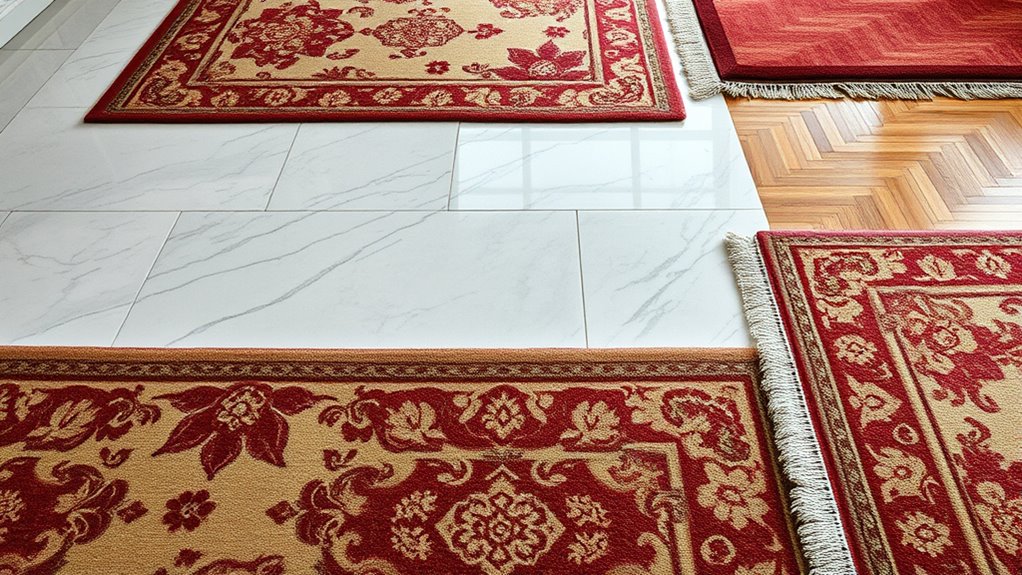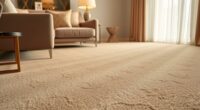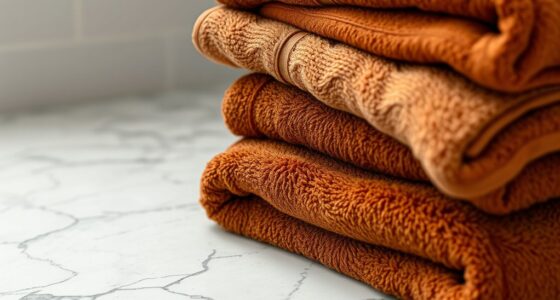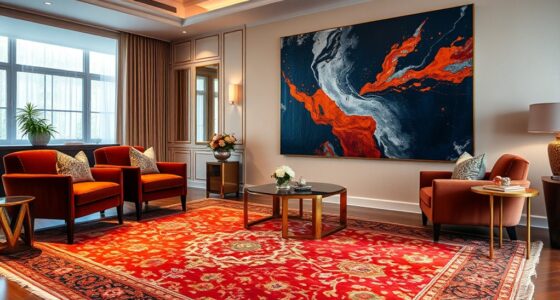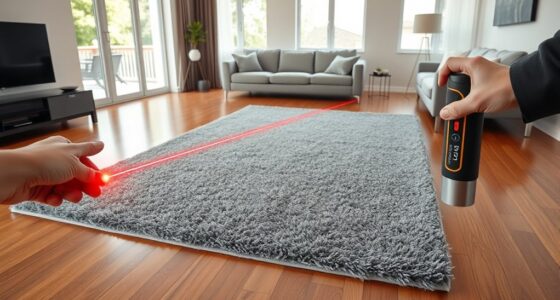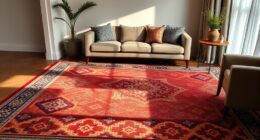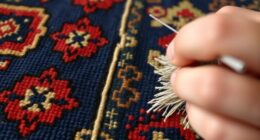Layering rugs over marble and parquet floors adds warmth, texture, and style to your space. Consider rug sizes and shapes that complement your room layout, mixing larger base rugs with smaller accents for depth. Choose colors and patterns that harmonize with your decor, and layer textures for visual interest. Use proper placement to protect your floors and enhance coziness. To discover how to style, maintain, and optimize layered rugs for your floors, explore more below.
Key Takeaways
- Choose rugs that complement the marble or parquet’s natural tones and patterns for cohesive layering.
- Use varied sizes and shapes, such as large base rugs with smaller accent rugs, to add depth and interest.
- Opt for dense, non-slip padding beneath layered rugs to prevent slipping and protect delicate flooring.
- Incorporate textures and patterns that contrast or harmonize with the floor’s surface for visual balance.
- Regularly rotate and maintain rugs to preserve their appearance and prevent damage to marble or parquet surfaces.
Choosing the Right Rug Sizes and Shapes
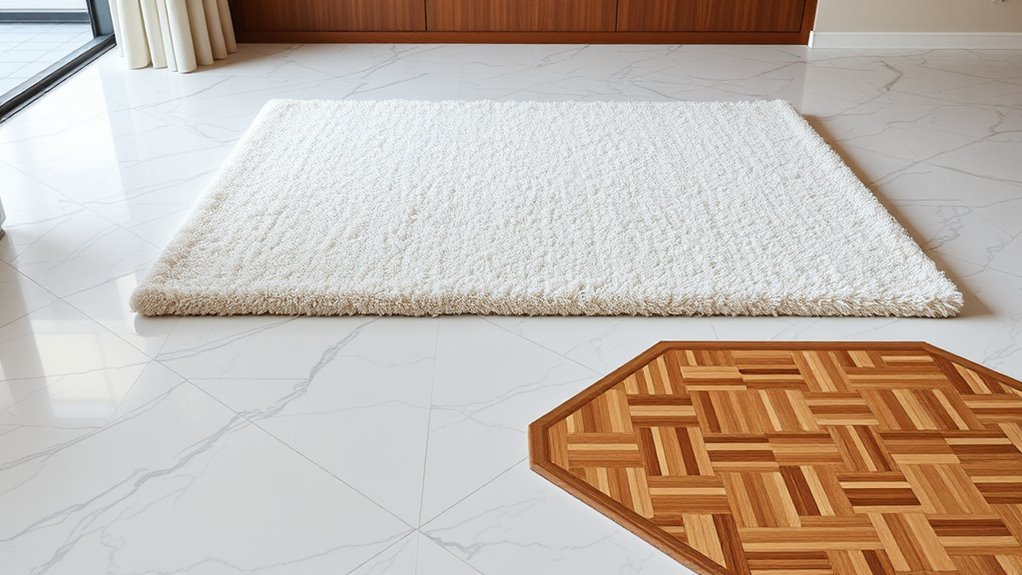
When selecting rugs for layering, it’s essential to choose the right sizes and shapes to create a balanced and cohesive look. Start by considering the overall space and furniture placement. Opt for rugs with varying sizes to add depth, such as a large base rug paired with smaller accent pieces. Pay attention to rug thickness; thicker rugs can add plushness and warmth, but ensure they don’t overpower the space or make furniture uncomfortable. Border designs also play a role—they can define each layer and add visual interest. Rounded or irregular shapes soften the look and break up straight lines, making the arrangement more inviting. Incorporating vintage decor elements can further enhance the layered effect and add rustic charm. By carefully choosing sizes, shapes, and design details, you’ll create a layered rug setup that enhances your floors beautifully.
Harmonizing Colors and Patterns
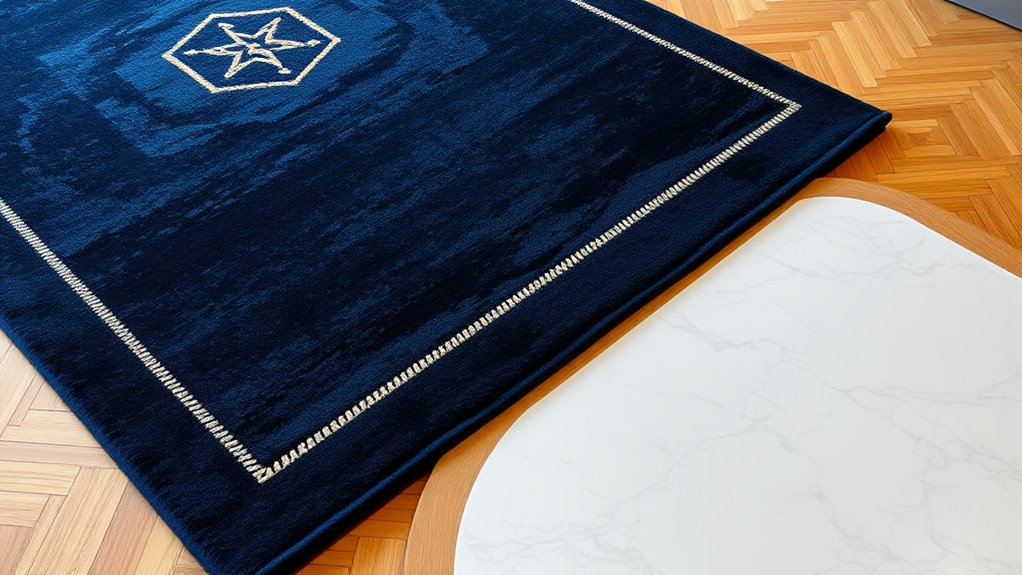
Harmonizing colors and patterns is key to creating a visually appealing layered rug arrangement. When you focus on color coordination, you guarantee the rugs complement your marble or parquet floors without clashing. Pattern blending helps create a cohesive look that feels intentional and balanced. To achieve this, consider these tips:
- Choose a dominant color to unify the layers and anchor the design.
- Mix subtle patterns with bold ones, ensuring they share a common color palette.
- Incorporate neutral tones to soften contrasting patterns and add harmony.
- Use repeating motifs or colors across layers to create a seamless flow.
- Paying attention to environmental considerations ensures your design choices support sustainable and eco-friendly practices.
Layering Techniques for a Cohesive Look
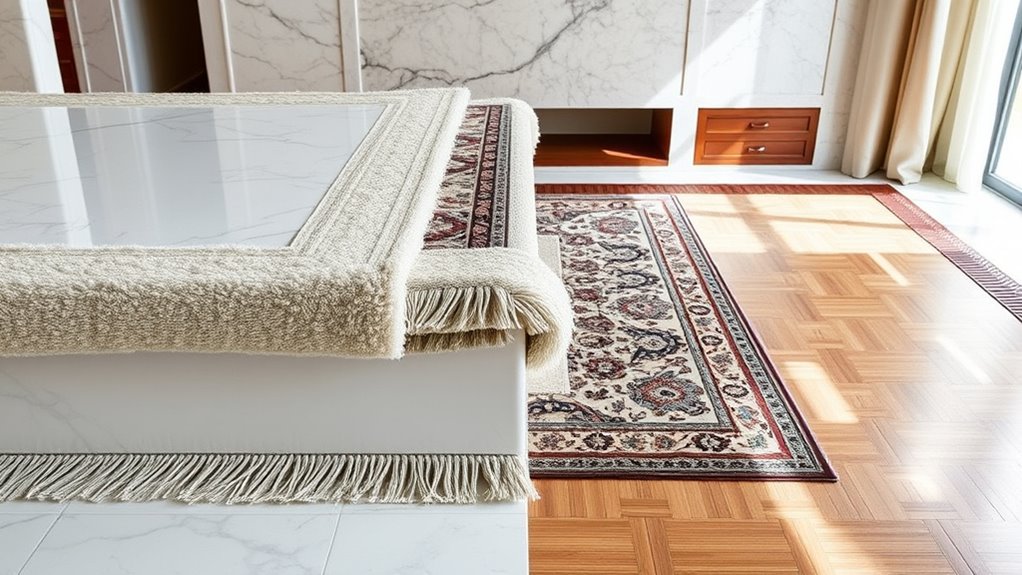
To achieve a cohesive layered rug look, you should carefully consider your arrangement and placement techniques. Mix patterns deliberately, balancing larger, bold designs with subtle ones to prevent visual clutter. Use contrast in textures—pair plush rugs with flat-woven pieces—to add depth without overwhelming your floors. Overlap rugs slightly, ensuring the edges align for a tidy appearance, and vary sizes for visual interest. Consider a focal point, like a marble or parquet feature, and layer rugs around it to anchor the space. Use this table as a guide:
| Pattern Mixing | Texture Contrast | Placement Tips |
|---|---|---|
| Combine geometric & floral | Pair shaggy with smooth | Overlap rugs slightly |
| Use complementary colors | Mix soft and rough textures | Vary rug sizes |
| Balance bold & subtle designs | Add layered depth | Maintain symmetry |
This approach creates harmony and visual interest in your room.
Material Considerations for Durability and Comfort
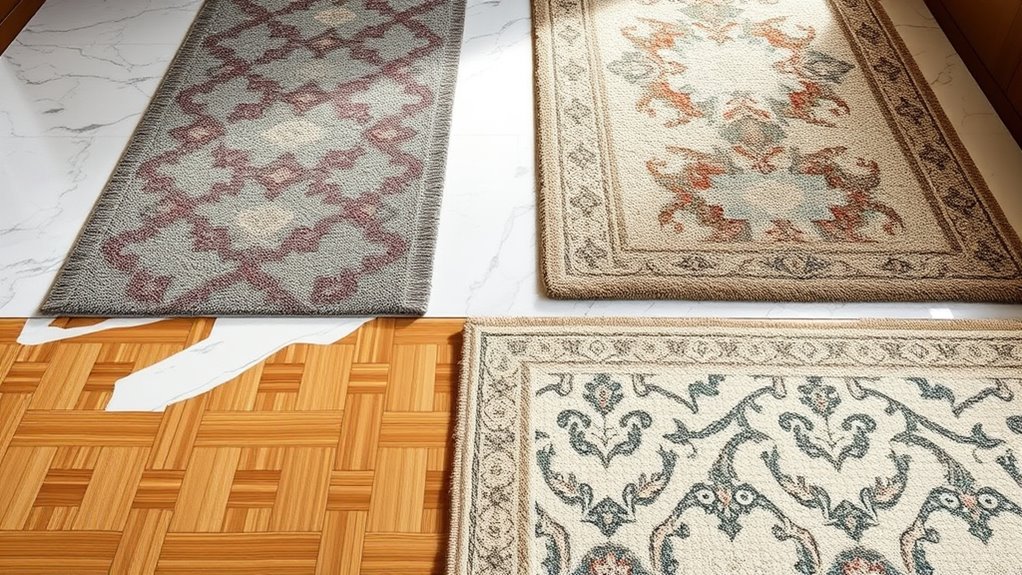
When choosing materials for layered rugs, consider how well they hold up to foot traffic and daily wear. You’ll also want to find a balance between softness for comfort and durability for long-term use. Additionally, think about how easy it is to clean and maintain each material to keep your layered look fresh. Being aware of the long-term consequences of infidelity can inform your choices, ensuring your space remains resilient and inviting over time.
Material Durability and Wear
Choosing the right material for your layered rugs is vital because it directly affects how well they withstand daily wear and tear. Durable textile weaves, like tightly woven fibers, resist crushing and fraying, extending your rug’s lifespan. Proper rug padding also plays an important role; it absorbs impact, reduces movement, and prevents slipping, protecting both the rug and your floor. To guarantee longevity, consider these factors:
- Select high-quality textile weaves that resist abrasion.
- Use dense, non-slip rug padding for stability and protection.
- Avoid delicate fibers that show wear quickly.
- Regularly rotate rugs to distribute wear evenly.
Focusing on these elements helps your layered rugs stay beautiful and functional on marble or parquet floors over time.
Comfort and Softness Levels
Ever wondered how the softness of your layered rugs impacts comfort without sacrificing durability? Texture contrast plays a key role here, allowing you to combine plush, soft rugs with firmer materials, creating a cozy feel underfoot. Softer rugs add a layer of comfort, making your space inviting, while maintaining durability guarantees they last. Additionally, layered rugs can provide acoustic benefits by absorbing sound and reducing noise, especially on hard floors like marble and parquet. By choosing plush textures, you enhance comfort, and through strategic layering, you balance softness with resilience. Incorporating rug materials that promote longevity ensures your layered setup remains both comfortable and durable. This approach not only elevates your space’s tactile experience but also dampens echo and noise, improving overall comfort without compromising the longevity of your flooring and rugs.
Maintenance and Cleaning Ease
Selecting rugs that are easy to maintain and clean is essential for preserving their appearance and functionality over time. When choosing layered rugs for marble or parquet floors, consider materials that resist stains and dust. This makes cleaning simpler and keeps your space looking fresh. Incorporating spiritual guidance into your choice can also help select materials that resonate with your personal energy and intentions. Here are four tips to improve maintenance and cleaning ease:
- Opt for low-pile or flat-weave rugs, which are easier to vacuum thoroughly.
- Choose materials like wool or synthetic fibers that resist stains and can be spot cleaned.
- Use rug pads to prevent shifting, making cleaning more efficient.
- Regularly shake out or vacuum to prevent dirt buildup, and spot clean spills immediately.
Placement Strategies Over Marble and Parquet Floors
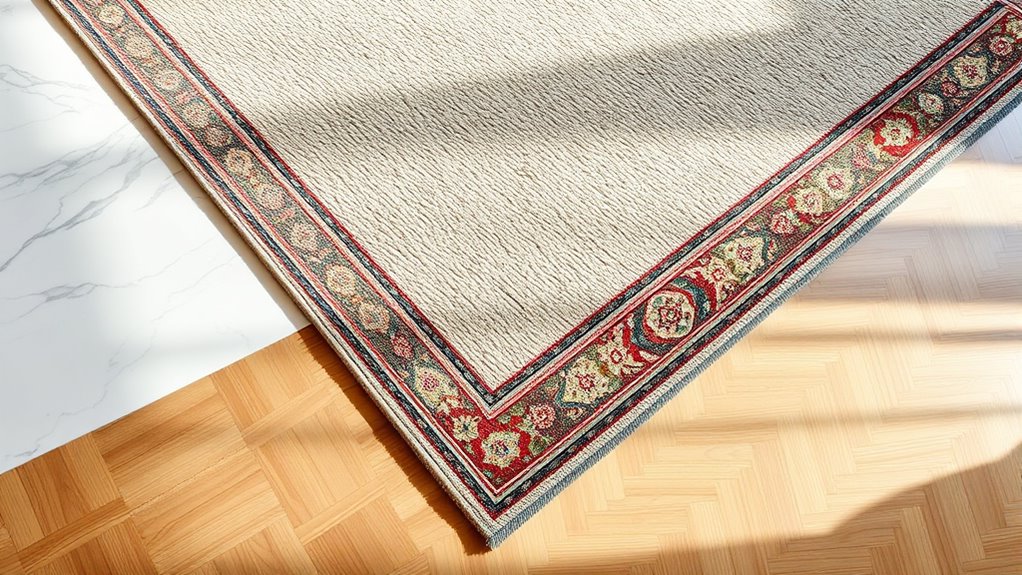
When layering rugs over marble and parquet floors, strategic placement is essential to enhance their natural beauty and protect the surfaces. Start by considering rug thickness; thinner rugs typically stay flat and avoid slipping, while thicker ones can add comfort but may require extra support. Use the right adhesive options to secure your rugs if needed, especially in high-traffic areas. Non-slip pads are a good choice for added stability without damaging the floor. Be mindful of rug size and positioning—center them to create balance, or layer smaller rugs for visual interest. Avoid placing rugs in areas prone to moisture or direct sunlight, which can cause damage over time. Proper placement not only elevates your decor but also preserves the integrity of your marble and parquet floors. Additionally, understanding electric power generation with bike generators can inspire sustainable energy solutions for your home or outdoor spaces.
Styling Tips for Different Interior Themes
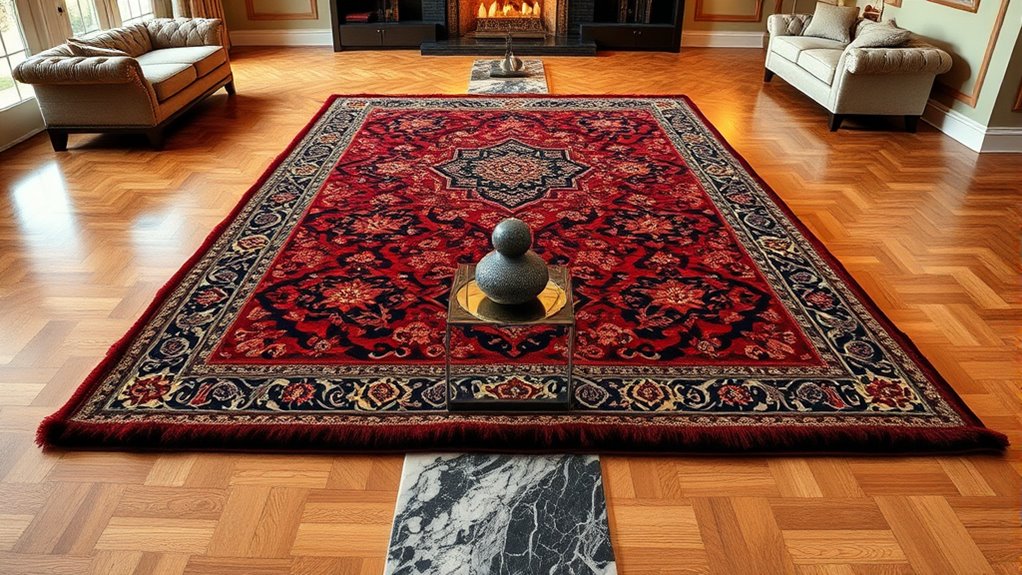
Choosing the right rugs to layer over your floors can considerably enhance your interior theme. For a modern look, opt for rugs with sleek textures and thinner rug thicknesses that complement minimalist designs. If you’re aiming for a cozy, traditional vibe, choose rugs with plush textures and thicker rugs to add warmth. For rustic or farmhouse themes, natural fiber rugs with rougher textures work best. In industrial spaces, go for rugs with a rugged texture and low pile to match the raw aesthetics. Remember, mixing rug textures can elevate visual interest, while matching rug thickness to your furniture height ensures harmony. Additionally, selecting self-watering plant pots with appropriate styles and materials can subtly influence the overall ambiance, especially in spaces that incorporate greenery. Balancing these elements helps your layered rugs seamlessly fit your interior theme, creating a cohesive and stylish space.
Maintenance and Care for Layered Rugs
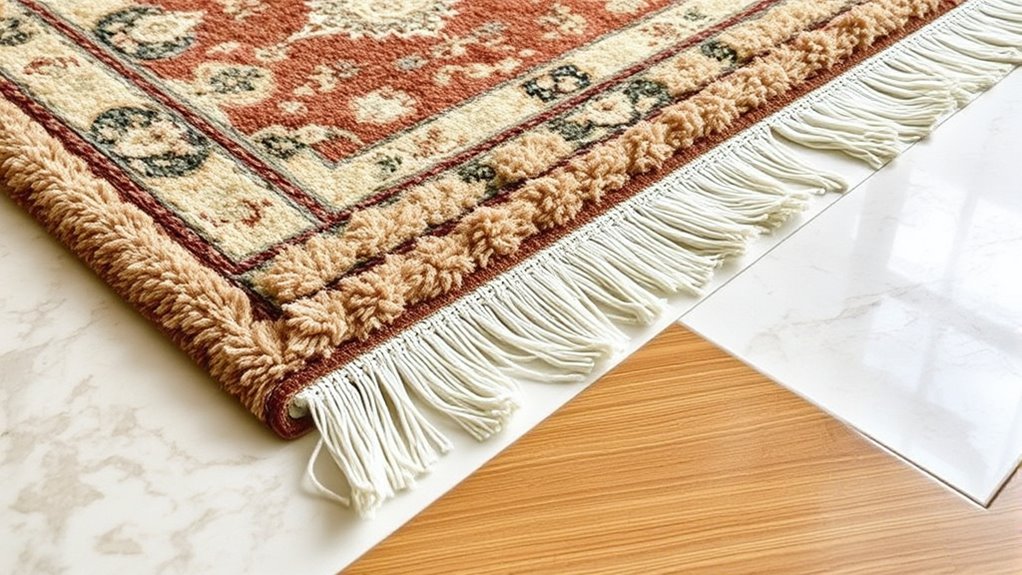
Maintaining layered rugs requires regular attention to keep them looking fresh and prevent damage. Start by ensuring proper rug padding underneath to provide cushioning and prevent slipping, which also helps protect your floors. Vacuum both the top and bottom of the rugs frequently to remove dirt and debris that can cause wear. To prevent stains, address spills immediately by blotting with a clean cloth and avoid harsh chemicals. Rotate the rugs periodically to distribute wear evenly and preserve their appearance. Regularly check for signs of fraying or loosened edges, and fix them promptly. Keep the layered setup clean and dry, especially around the edges, to prevent mold or mildew. Proper care extends the life of your layered rugs and maintains the elegant look of your floors. Additionally, inspecting for quality assessment can help identify early signs of deterioration and guide effective preservation efforts.
Frequently Asked Questions
How Does Rug Layering Affect Room Acoustics and Sound Insulation?
When you layer rugs in your space, you can substantially improve soundproofing benefits and acoustic enhancement. The additional layers absorb and dampen sound waves, reducing echo and noise transfer between rooms. This creates a quieter, more comfortable environment. By choosing the right textures and thicknesses, you can optimize sound absorption, making your room feel cozier and more insulated from outside noise, all while adding style and depth to your flooring.
What Are the Best Practices for Preventing Rug Slippage on Marble and Parquet?
You might wonder if your rugs will slip on marble or parquet floors. The truth is, using non-slip pads under your rugs substantially reduces movement. For extra security, make sure the rug edging is properly secured and smooth. You can also choose pads with adhesive backing for added grip. These practices keep your rugs in place, preventing accidents and protecting your beautiful floors.
Can Layered Rugs Help in Hiding Floor Imperfections or Damages?
Layered rugs can definitely help with floor damage concealment, making imperfections less noticeable. By strategically placing rugs, you enhance your space’s aesthetic and draw attention away from any flaws. Layering also adds texture and depth, creating a cozy, stylish look. You’ll love how this technique not only hides damages but elevates your room’s overall design, giving it a fresh, inviting feel while protecting your floors.
How Do Seasonal Changes Impact Rug Layering Strategies?
You should consider seasonal changes when layering rugs, as they influence your seasonal decor and color coordination choices. In warmer months, lighter, breezy rugs work well, while in colder seasons, plush, cozy layers add warmth. Adjust your rug layering strategy accordingly, balancing textures and colors to reflect the season. This approach keeps your space stylish and comfortable year-round, ensuring your layered rugs complement your seasonal decor and enhance your overall aesthetic.
Are There Specific Cleaning Methods for Layered Rugs on Delicate Floors?
When cleaning layered rugs on delicate floors, you should focus on gentle dirt removal and stain treatment. Use a soft brush or vacuum with no beater bar to avoid scratching. For stains, blot with a damp cloth and mild detergent—avoid harsh chemicals. Always lift rugs carefully to prevent damage, and test cleaning solutions on a small area first. This approach protects your delicate floors while keeping your layered rugs clean.
Conclusion
Layering rugs over marble and parquet floors transforms your space, blending elegance with comfort. While the sleek, cool surfaces demand durability and style, your layered rugs add warmth and personality. It’s a delicate balance—where sophistication meets coziness, and craftsmanship meets everyday practicality. By thoughtfully choosing and placing your rugs, you create a harmonious haven that’s both visually stunning and inviting—proving that contrast can be your greatest design asset.
